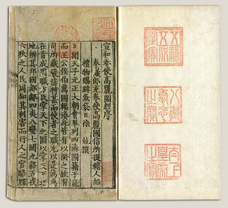TELDAP Collections
| Illustrated Text of the Hsüan-ho Emissary to Korea |
|
Sung Dynasty (960-1279) Geographical and travel texts have a long history in China, extending as far back as the Shang and Chou dynasties (17th-3rd c. BC), when specific officials dealt with compiling and organizing geographical texts. And following “Fo-kuo chi (Record of the Land of the Buddha)” by the Chin (265-317) monk Fa-hsien, such texts became increasingly popular. "Outside records" were a source for ancient Chinese to understand foreign matters. This book is an imprint made in 1167, representing the earliest known edition of this text. China and Korea, due to their geographical proximity, have long had close ties. Consequently, information about Korea in Chinese records is quite plentiful. In addition to individual references to things Korean, many Chinese texts are known to have dealt specifically with Korea. Although some of them have survived, Hsü Ching's text is probably the richest in terms of content. It is also the oldest text, making it a precious source of information in the study of ancient Sino-Korean relations and the history of foreign communications. Hsü Ching originally completed the text, including illustrations, in 1124. However, with the fall of the Northern Sung in 1126, the illustrations were lost. In 1167, Hsü Ch'an, the nephew of Hsü Ching, had the text printed for the first time. Although unable to retrieve the illustrations, he nonetheless referred to them in the title of the printing. From that time to the middle of the Ming dynasty (1368-1644), the book was not reprinted. At the end of the Ming, the text was transcribed and reprinted, and the editors of the Ssu-k'u ch'uan-shu (Complete Library of the Four Treasuries) in the Ch'ing dynasty (1644-1911) also transcribed it, but both editions are marred by numerous errors and omissions. In 1793, Pao T'ing-po took a transcribed edition in his collection along with the Ming reprinting and had it reprinted as part of his “Chih-pu-chai Studio” series. However, he also made errors in the process, resulting in discrepancies with the original 1167 printing, making it all the more important for cross-referencing with later printings. This sole surviving example of the 1167 printing is also noted for the exceptional quality of the carving of the upright standard-script characters.
|













